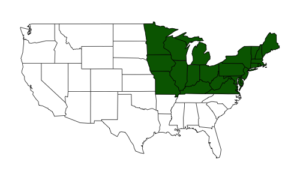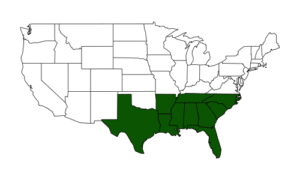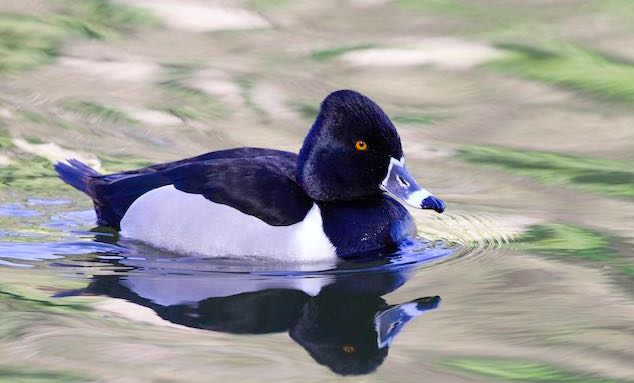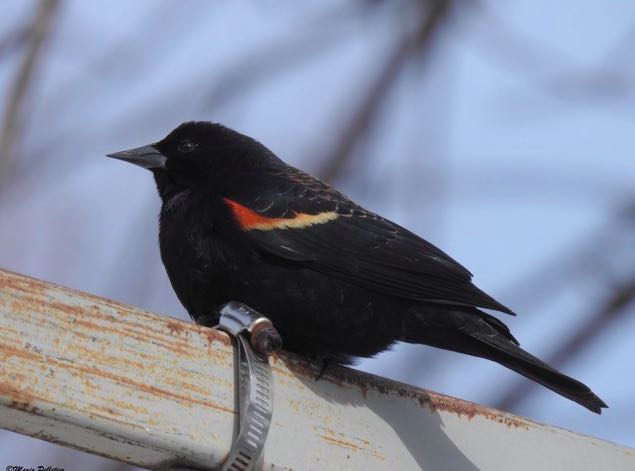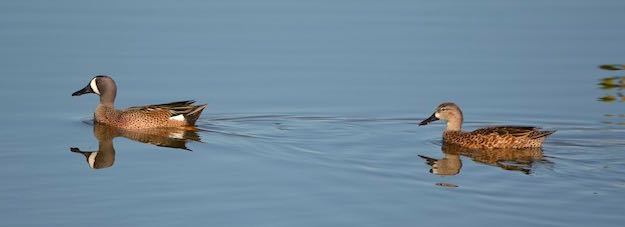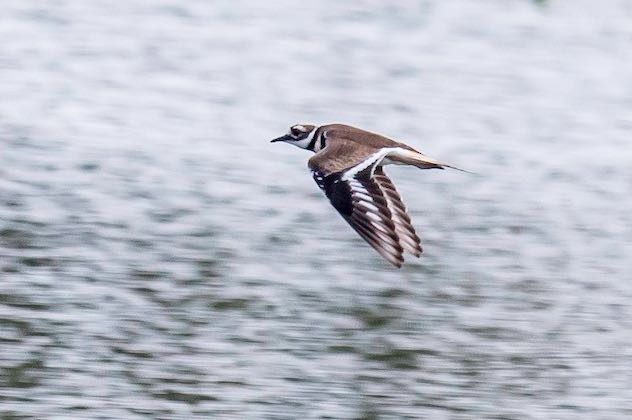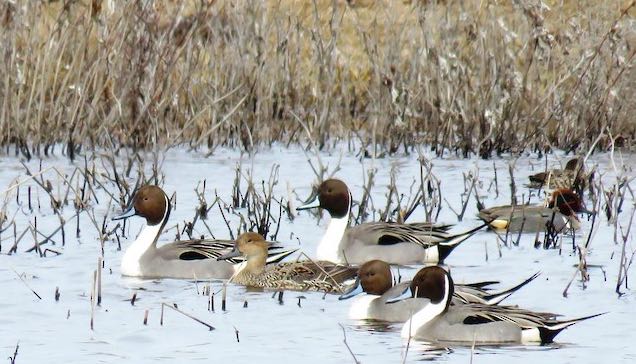Ring-necked Duck. Peter Seubert/Macaulay Library. eBird S34919705.
Continental Summary
A favorable weekend forecast will see light to locally moderate flights of numerous species of waterfowl, Tree Swallow, Northern Rough-winged Swallow, and Ruby-crowned Kinglet in the West, while a weekend blast of winter cold precedes a serious of much more favorable spring like days with moderate to locally heavy flights of waterfowl, Killdeer, Eastern Phoebe, and Red-winged Blackbird in the East.
Arrows show wind speed and direction (arrow points in the direction to which wind is blowing) 100 m above ground level. Areas with southerly winds are colored red; northerly winds colored blue. Accumulated precipitation (in 6 hour intervals) is green, outlined by white. Broadly speaking, areas of the map in red will experience conditions that are favorable for migration, and areas where red and green (and red and blue) intersect and overlap may experience migrant concentrations and fallouts as migrants interact with precipitation.
We use data collected by eBird users help make more accurate forecasts. If you enjoy the predictions contained in these posts, please consider submitting your own bird sightings to eBird to even further improve the content. Every observation counts, whether it be a single bird at a feeder in your backyard, or an entire day spent in a national park. To get started with eBird, head on over to the site !
Please note that photographs and other digital media showing birds come from the Macaulay Library , which receives credit along with the photographer/observer in the media caption as part of a new initiative that allows public contribution, access and use of natural history media .
Finally, and new for Spring 2017 , our friend Kyle Horton of the Radar Aeroecology Lab at Oklahoma University created a new set of images depicting spring bird movements in the Gulf of Mexico region as part of an analysis that he is leading as part of our ongoing collaboration. This feature appears in the Gulf Coast and Southeast region forecast.
Need a review of our definitions for regions, species on the move, and migration amounts? Please visit this link .
Quick Links to Regions
Upper Midwest and Northeast
A quite and cold start to the weekend will yield little or no movement in most areas. But warmer air and more southerly flow return quickly to the Midwest by Saturday and Sunday and then eventually to the entirety of the region by Monday. Moderate to locally heavy flights will follow in this warm wave. And following this warm wave will be a significant frontal boundary that will shut down most movements by Wednesday and Thursday. Scattered light to moderate flights may occur to end the period in the pockets of marginal or locally favorable conditions primarily in the Midwest.
Red-winged Blackbird. Mario Pelletier/Macaulay Library. eBird S34919394.
Species on the Move
Species
Noticeability
Migrants Begin Arriving
Rapid Migrant Influx
Peak
Rapid Migrant Departure
Last Migrants Depart
Purple Finch
*
2/2
4/12
4/25
5/7
5/16
American Wigeon
***
2/17
2/27
3/16
4/14
4/28
Red-winged Blackbird
****!
2/18
3/3
5/5
5/20
After Jun 30
Tundra Swan
**
2/19
2/27
3/12
3/30
4/17
Gadwall
***
2/19
2/28
3/17
4/18
5/2
Canvasback
**
2/19
2/27
3/11
3/27
4/25
Redhead
***
2/19
2/27
3/12
3/27
4/28
Lesser Scaup
***
2/19
3/1
3/21
4/18
5/5
Common Merganser
***
2/19
2/27
3/12
4/16
4/29
Common Grackle
****!
2/19
3/6
5/14
6/6
After Jun 30
Northern Shoveler
***
2/20
3/5
4/4
4/26
5/11
Green-winged Teal
***
2/20
3/7
3/31
4/24
5/10
Ring-necked Duck
***
2/20
3/3
3/23
4/16
5/1
Greater Scaup
**
2/20
2/27
3/9
4/18
4/30
Hooded Merganser
***
2/20
3/2
3/18
4/8
4/24
Red-breasted Merganser
***
2/20
2/27
3/14
4/21
5/5
Northern Harrier
*
2/20
3/30
4/8
4/23
5/5
Killdeer
***
2/20
3/6
3/30
6/3
6/13
American Woodcock
***
2/20
3/3
3/21
4/6
6/3
Ring-billed Gull
***
2/20
2/27
3/13
4/18
4/28
Bufflehead
***
2/21
3/2
3/28
4/21
5/6
Ruddy Duck
**
2/21
3/2
4/1
4/25
5/10
American Coot
***
2/21
3/3
4/6
5/1
5/21
Herring Gull
***
2/21
2/27
3/9
4/18
6/6
Surf Scoter
*
2/23
2/27
3/5
4/19
4/28
Black Scoter
*
2/23
2/27
3/5
3/18
6/1
Rusty Blackbird
**
2/23
3/8
4/10
5/1
5/13
Great Cormorant
*
2/24
2/27
3/4
3/20
4/24
Horned Grebe
***
2/26
3/9
3/27
4/17
5/7
American Kestrel
**
2/26
3/30
4/12
4/28
5/11
Fox Sparrow
***
3/1
3/21
4/2
4/19
4/29
Great Blue Heron
***
3/2
3/21
5/14
5/28
6/7
Pied-billed Grebe
***
3/3
3/25
4/9
4/27
5/12
Peaking Arrivals
Species
Noticeability
Migrants Begin Arriving
Rapid Migrant Influx
Peak
Rapid Migrant Departure
Last Migrants Depart
Horned Lark
*
2/17
2/24
3/6
3/20
After Jun 30
Brant
*
2/19
2/24
3/4
5/26
6/4
Snow Goose
**
2/15
2/25
3/9
3/26
4/13
American Black Duck
***
2/20
2/26
3/10
4/16
4/26
Northern Pintail
***
2/16
2/26
3/11
3/27
4/22
Long-tailed Duck
*
2/22
2/26
3/5
3/18
4/26
Common Goldeneye
**
2/20
2/26
3/8
3/24
4/23
Red-throated Loon
*
2/21
2/26
3/7
4/20
4/30
Bald Eagle
**
2/19
2/26
3/10
5/26
6/7
Rough-legged Hawk
*
2/21
2/26
3/5
3/21
4/9
Tundra Swan
**
2/19
2/27
3/12
3/30
4/17
American Wigeon
***
2/17
2/27
3/16
4/14
4/28
Canvasback
**
2/19
2/27
3/11
3/27
4/25
Redhead
**
2/19
2/27
3/12
3/27
4/28
Greater Scaup
*
2/20
2/27
3/9
4/18
4/30
Surf Scoter
*
2/23
2/27
3/5
4/19
4/28
Black Scoter
*
2/23
2/27
3/5
3/18
6/1
Common Merganser
***
2/19
2/27
3/12
4/16
4/29
Red-breasted Merganser
**
2/20
2/27
3/14
4/21
5/5
Ring-billed Gull
***
2/20
2/27
3/13
4/18
4/28
Herring Gull
***
2/21
2/27
3/9
4/18
6/6
Great Cormorant
*
2/24
2/27
3/4
3/20
4/24
Gadwall
***
2/19
2/28
3/17
4/18
5/2
Lesser Scaup
***
2/19
3/1
3/21
4/18
5/5
Bufflehead
***
2/21
3/2
3/28
4/21
5/6
Hooded Merganser
***
2/20
3/2
3/18
4/8
4/24
Ruddy Duck
*
2/21
3/2
4/1
4/25
5/10
Ring-necked Duck
***
2/20
3/3
3/23
4/16
5/1
American Coot
**
2/21
3/3
4/6
5/1
5/21
American Woodcock
**
2/20
3/3
3/21
4/6
6/3
Red-winged Blackbird
***
2/18
3/3
5/5
5/20
After Jun 30
Northern Shoveler
***
2/20
3/5
4/4
4/26
5/11
Killdeer
***
2/20
3/6
3/30
6/3
6/13
Common Grackle
***
2/19
3/6
5/14
6/6
After Jun 30
Beginning Departures
Species
Noticeability
Migrants Begin Arriving
Rapid Migrant Influx
Peak
Rapid Migrant Departure
Last Migrants Depart
Not too much happening here yet!
Ending Departures
Species
Noticeability
Migrants Begin Arriving
Rapid Migrant Influx
Peak
Rapid Migrant Departure
Last Migrants Depart
Check back in the coming weeks!
Gulf Coast and Southeast
A striking duality defines the region to begin the weekend, with favorable migration conditions spawning moderate flights in Texas and west of the Mississippi River and unfavorable conditions to the east spawning little if any local movement. But beginning on Sunday increasingly favorable conditions for migration spread east and spawn moderate flights that are significantly more widespread over the region. Scattered precipitation has the look of fallout conditions, but generally unfavorable conditions on Sunday night suggest this is mostly wishful thinking; however, Monday night is forecast to have more favorable flight conditions from points further south, and an intensifying frontal boundary is worth watching for those keen on experiencing a very early season concentration of migrants from the upper Texas coast to the Florida Panhandle. With the passage of this frontal boundary, unfavorable conditions build into the region for most of the remainder of the period.
Blue-winged Teal. Bill Uttenweiler/Macaulay Library. eBird S34917890.
Species
Noticeability
Migrants Begin Arriving
Rapid Migrant Influx
Peak
Rapid Migrant Departure
Last Migrants Depart
Purple Martin
***
2/2
3/2
6/18
After Jun 30
-
Osprey
***
2/19
2/27
3/13
4/24
5/5
Long-billed Curlew
*
2/19
2/27
3/13
4/27
5/13
Tree Swallow
***
2/19
2/28
3/18
4/28
5/25
Blue-winged Teal
***
2/20
3/4
4/7
5/4
5/26
Brown Pelican
***
2/20
2/27
4/14
4/30
5/10
Glossy Ibis
**
2/20
2/27
3/10
3/25
4/24
Common Gallinule
***
2/20
2/27
3/10
4/30
5/9
American Coot
***
2/20
2/27
3/9
4/22
5/10
Laughing Gull
***
2/20
4/6
4/17
5/2
5/12
Double-crested Cormorant
***
2/21
2/27
3/11
4/20
5/4
Great Blue Heron
***
2/21
2/27
3/10
3/21
5/26
Caspian Tern
*
2/21
4/5
4/14
5/3
5/16
Cedar Waxwing
***
2/21
3/2
3/28
5/20
5/29
Northern Parula
***
2/21
3/11
4/19
After Jun 30
-
Palm Warbler
***
2/21
2/27
3/10
5/2
5/15
Spotted Towhee
*
2/21
3/2
3/19
4/27
5/9
Northern Shoveler
**
2/22
2/27
3/8
4/23
5/21
Horned Grebe
*
2/22
2/27
3/7
3/24
4/14
American Bittern
*
2/22
2/27
3/8
4/29
5/14
Northern Harrier
*
2/22
2/27
3/6
4/22
5/6
Bald Eagle
**
2/22
2/28
3/8
3/24
5/21
Dunlin
*
2/22
4/5
4/20
5/24
6/7
Western Sandpiper
*
2/22
3/2
4/10
5/19
6/1
Wilson's Snipe
*
2/22
2/28
3/10
4/18
5/3
Herring Gull
*
2/22
2/27
3/6
4/26
5/8
Belted Kingfisher
***
2/22
2/27
3/8
4/18
4/29
Cooper's Hawk
*
2/23
3/2
3/12
4/27
5/19
Sanderling
*
2/23
4/5
4/17
6/1
6/12
Greater Yellowlegs
**
2/23
3/4
4/5
5/5
5/21
Northern Flicker
**
2/23
3/1
3/11
4/3
4/18
Vesper Sparrow
*
2/23
3/2
3/14
5/1
5/19
Savannah Sparrow
**
2/23
3/1
3/12
5/8
5/21
Sharp-shinned Hawk
*
2/24
2/27
3/3
4/25
5/11
Ruddy Turnstone
*
2/24
4/10
4/25
5/28
6/12
Forster's Tern
*
2/24
3/1
3/9
5/3
5/17
Blue-headed Vireo
**
2/24
3/4
4/8
5/15
5/26
Golden-crowned Kinglet
*
2/24
3/1
3/8
3/29
4/14
Lincoln's Sparrow
**
2/24
3/6
4/15
5/6
5/19
Swamp Sparrow
**
2/24
3/2
3/12
4/25
5/8
Willet
**
2/25
4/6
4/16
5/2
5/12
Royal Tern
**
2/25
4/5
4/16
5/1
5/11
Ruby-crowned Kinglet
***
2/25
3/4
3/24
4/20
5/4
Yellow-crowned Night-Heron
**
2/26
4/8
5/1
5/11
5/17
Bonaparte's Gull
*
2/26
3/2
3/10
4/8
4/24
Rusty Blackbird
*
2/26
2/28
3/4
3/25
4/11
Black-bellied Plover
*
2/27
4/11
4/24
5/13
5/30
Wilson's Plover
*
2/27
3/10
4/21
5/5
5/13
Marbled Godwit
*
2/27
4/2
4/13
4/30
5/10
Couch's Kingbird
**
2/27
3/11
4/3
5/7
5/20
Yellow-throated Warbler
***
2/27
3/22
4/10
4/24
After Jun 30
Least Sandpiper
**
2/28
4/20
5/1
5/18
5/29
Short-billed Dowitcher
*
2/28
4/7
4/19
5/7
5/21
Long-billed Dowitcher
*
2/28
4/11
4/21
5/7
5/18
Lesser Yellowlegs
**
2/28
4/11
4/23
5/12
5/24
Winter Wren
*
2/28
3/4
3/9
4/2
4/16
Common Loon
*
3/1
3/4
3/11
4/18
5/3
Brown-headed Cowbird
***
3/1
3/17
4/30
5/15
After Jun 30
American Golden-Plover
**
3/2
3/14
3/31
4/20
5/15
Black-bellied Whistling-Duck
***
3/3
3/16
4/23
5/6
5/15
Piping Plover
*
3/3
4/5
4/15
5/2
5/11
Northern Rough-winged Swallow
***
3/3
3/18
4/27
After Jun 30
-
Barn Swallow
***
3/3
3/21
5/2
5/17
5/27
Hermit Thrush
**
3/3
3/10
3/20
4/10
4/25
Black-and-white Warbler
***
3/3
4/15
4/25
5/10
5/21
Golden-cheeked Warbler
*
3/3
3/12
3/27
4/4
6/13
Black-necked Stilt
***
3/4
3/16
4/19
5/4
5/14
Pectoral Sandpiper
**
3/4
3/15
4/29
5/18
5/29
White-eyed Vireo
***
3/4
3/24
4/16
After Jun 30
-
Black-chinned Hummingbird
***
3/5
3/16
5/5
5/21
6/1
Peaking Arrivals
Species
Noticeability
Migrants Begin Arriving
Rapid Migrant Influx
Peak
Rapid Migrant Departure
Last Migrants Depart
Chipping Sparrow
**
-
2/2
3/29
4/11
5/18
Cinnamon Teal
*
2/2
2/14
3/8
4/17
5/8
Redhead
*
2/19
2/23
3/1
3/16
3/25
Sandhill Crane
*
2/18
2/23
3/2
3/18
3/29
Ring-necked Duck
*
2/20
2/24
3/2
3/19
4/1
Harris's Sparrow
*
2/20
2/24
3/2
3/18
5/6
American Wigeon
*
2/21
2/25
3/3
3/19
4/18
Lesser Scaup
*
2/20
2/25
3/5
3/21
4/17
Ruddy Duck
*
2/21
2/25
3/3
3/17
4/26
American White Pelican
*
2/20
2/25
3/4
3/22
4/27
Ring-billed Gull
**
2/22
2/25
3/3
3/19
4/28
Eastern Phoebe
***
2/19
2/25
3/6
3/20
3/31
Gadwall
*
2/21
2/26
3/5
3/22
4/21
Green-winged Teal
*
2/20
2/26
3/6
4/15
4/26
Bufflehead
*
2/22
2/26
3/3
3/26
4/14
Red-breasted Merganser
*
2/20
2/26
3/8
4/21
5/3
Pied-billed Grebe
***
2/20
2/26
3/7
4/19
5/1
American Kestrel
**
2/21
2/26
3/5
3/23
4/11
Yellow-rumped Warbler
***
2/20
2/26
3/8
5/1
5/16
Northern Shoveler
*
2/22
2/27
3/8
4/23
5/21
Horned Grebe
*
2/22
2/27
3/7
3/24
4/14
Double-crested Cormorant
***
2/21
2/27
3/11
4/20
5/4
Brown Pelican
*
2/20
2/27
4/14
4/30
5/10
American Bittern
*
2/22
2/27
3/8
4/29
5/14
Great Blue Heron
***
2/21
2/27
3/10
3/21
5/26
Glossy Ibis
*
2/20
2/27
3/10
3/25
4/24
Osprey
***
2/19
2/27
3/13
4/24
5/5
Northern Harrier
*
2/22
2/27
3/6
4/22
5/6
Sharp-shinned Hawk
*
2/24
2/27
3/3
4/25
5/11
Common Gallinule
**
2/20
2/27
3/10
4/30
5/9
American Coot
***
2/20
2/27
3/9
4/22
5/10
Long-billed Curlew
*
2/19
2/27
3/13
4/27
5/13
Herring Gull
*
2/22
2/27
3/6
4/26
5/8
Belted Kingfisher
**
2/22
2/27
3/8
4/18
4/29
Palm Warbler
**
2/21
2/27
3/10
5/2
5/15
Bald Eagle
*
2/22
2/28
3/8
3/24
5/21
Wilson's Snipe
*
2/22
2/28
3/10
4/18
5/3
Tree Swallow
***
2/19
2/28
3/18
4/28
5/25
Rusty Blackbird
*
2/26
2/28
3/4
3/25
4/11
Forster's Tern
*
2/24
3/1
3/9
5/3
5/17
Northern Flicker
**
2/23
3/1
3/11
4/3
4/18
Golden-crowned Kinglet
*
2/24
3/1
3/8
3/29
4/14
Savannah Sparrow
**
2/23
3/1
3/12
5/8
5/21
Cooper's Hawk
*
2/23
3/2
3/12
4/27
5/19
Western Sandpiper
*
2/22
3/2
4/10
5/19
6/1
Bonaparte's Gull
*
2/26
3/2
3/10
4/8
4/24
Purple Martin
**
2/2
3/2
6/18
After Jun 30
-
Cedar Waxwing
**
2/21
3/2
3/28
5/20
5/29
Vesper Sparrow
*
2/23
3/2
3/14
5/1
5/19
Swamp Sparrow
*
2/24
3/2
3/12
4/25
5/8
Spotted Towhee
*
2/21
3/2
3/19
4/27
5/9
Blue-winged Teal
***
2/20
3/4
4/7
5/4
5/26
Common Loon
*
3/1
3/4
3/11
4/18
5/3
Greater Yellowlegs
*
2/23
3/4
4/5
5/5
5/21
Blue-headed Vireo
*
2/24
3/4
4/8
5/15
5/26
Winter Wren
*
2/28
3/4
3/9
4/2
4/16
Ruby-crowned Kinglet
**
2/25
3/4
3/24
4/20
5/4
Lincoln's Sparrow
**
2/24
3/6
4/15
5/6
5/19
Beginning Departures
Species
Noticeability
Migrants Begin Arriving
Rapid Migrant Influx
Peak
Rapid Migrant Departure
Last Migrants Depart
Northern Pintail
**
-
-
Before Feb 1
3/13
3/24
Rufous Hummingbird
*
-
-
Before Feb 1
3/31
4/14
Yellow-bellied Sapsucker
***
-
-
Before Feb 1
3/31
4/20
Brown Creeper
*
-
-
Before Feb 1
3/30
4/11
Fox Sparrow
*
-
-
Before Feb 1
3/18
4/1
Dark-eyed Junco
***
-
2/2
2/16
4/3
4/13
Purple Finch
*
-
2/2
2/16
2/28
4/18
Pine Siskin
*
-
2/2
2/17
5/11
5/24
American Robin
***
-
2/2
2/19
3/12
5/24
Song Sparrow
***
2/20
2/22
2/26
3/29
4/15
Redhead
**
2/19
2/23
3/1
3/16
3/25
Ring-necked Duck
***
2/20
2/24
3/2
3/19
4/1
Sandhill Crane
**
2/18
2/23
3/2
3/18
3/29
Harris's Sparrow
*
2/20
2/24
3/2
3/18
5/6
American Wigeon
**
2/21
2/25
3/3
3/19
4/18
Bufflehead
**
2/22
2/26
3/3
3/26
4/14
Ruddy Duck
**
2/21
2/25
3/3
3/17
4/26
Sharp-shinned Hawk
*
2/24
2/27
3/3
4/25
5/11
Ring-billed Gull
***
2/22
2/25
3/3
3/19
4/28
American White Pelican
**
2/20
2/25
3/4
3/22
4/27
Rusty Blackbird
*
2/26
2/28
3/4
3/25
4/11
Gadwall
***
2/21
2/26
3/5
3/22
4/21
Lesser Scaup
***
2/20
2/25
3/5
3/21
4/17
American Kestrel
***
2/21
2/26
3/5
3/23
4/11
Green-winged Teal
**
2/20
2/26
3/6
4/15
4/26
Northern Harrier
***
2/22
2/27
3/6
4/22
5/6
Herring Gull
*
2/22
2/27
3/6
4/26
5/8
Eastern Phoebe
***
2/19
2/25
3/6
3/20
3/31
Ending Departures
Species
Noticeability
Migrants Begin Arriving
Rapid Migrant Influx
Peak
Rapid Migrant Departure
Last Migrants Depart
Snow Goose
*
-
-
Before Feb 1
2/3
3/22
Canvasback
*
-
-
Before Feb 1
2/3
3/24
Hooded Merganser
***
-
-
Before Feb 1
2/3
3/25
American Pipit
**
-
-
Before Feb 1
2/3
3/25
Orange-crowned Warbler
***
-
-
Before Feb 1
2/3
5/11
Purple Finch
*
-
2/2
2/16
2/28
4/18
Great Plains
A broad area of favorable migration conditions blankets the region for the weekend, with moderate to locally heavy flights in most areas. By Monday night, however, a frontal passage will shut down most of these flights. The remainder of the period sees pockets of marginal and favorable conditions for migrants to move, particularly on Wednesday and Thursday nights in the central and southern Plains; these movements will be mostly moderate and local.
Killdeer. David Hall/Macaulay Library. eBird S34918031.
Species on the Move
Species
Noticeability
Migrants Begin Arriving
Rapid Migrant Influx
Peak
Rapid Migrant Departure
Last Migrants Depart
Ring-necked Duck
***
2/15
2/27
3/15
4/6
5/10
American Wigeon
***
2/16
3/1
3/24
4/20
After Jun 30
Gadwall
***
2/18
2/28
3/26
After Jun 30
-
Green-winged Teal
***
2/18
3/6
3/29
4/21
5/12
Lesser Scaup
***
2/18
3/2
3/31
4/20
After Jun 30
Cinnamon Teal
*
2/19
4/5
4/18
5/4
5/16
Bufflehead
***
2/20
3/3
3/21
4/13
5/10
Northern Harrier
***
2/20
2/27
3/13
4/22
After Jun 30
Sandhill Crane
***
2/20
3/3
3/18
4/3
4/17
Killdeer
****!
2/20
3/6
4/1
5/1
After Jun 30
American White Pelican
***
2/21
3/31
4/13
After Jun 30
-
Rough-legged Hawk
***
2/21
2/27
3/8
3/22
4/5
American Pipit
**
2/21
3/6
4/19
5/7
5/19
American Tree Sparrow
***
2/21
2/27
3/7
3/24
4/11
Red-breasted Merganser
*
2/22
3/6
3/21
4/11
4/27
Horned Grebe
**
2/23
4/1
4/16
5/5
5/17
Golden-crowned Kinglet
*
2/23
2/28
3/13
4/15
4/25
Lapland Longspur
*
2/24
2/27
3/6
3/20
3/31
Northern Shoveler
***
2/25
3/19
4/13
5/7
After Jun 30
American Coot
***
2/25
4/2
4/18
5/7
5/22
Ruddy Duck
***
2/26
3/14
4/8
After Jun 30
-
Wood Duck
***
2/27
3/26
5/7
5/25
6/5
Wilson's Snipe
**
2/27
3/31
4/15
After Jun 30
-
Great Blue Heron
***
2/28
3/26
4/24
5/19
After Jun 30
Fox Sparrow
*
3/1
3/9
3/23
4/15
4/29
Song Sparrow
***
3/1
3/16
4/1
4/15
4/25
Common Grackle
****!
3/2
3/16
5/24
6/10
6/24
Greater Yellowlegs
***
3/5
3/25
4/15
5/4
5/18
Peaking Arrivals
Species
Noticeability
Migrants Begin Arriving
Rapid Migrant Influx
Peak
Rapid Migrant Departure
Last Migrants Depart
Rusty Blackbird
*
2/17
2/23
3/3
3/17
4/21
Greater White-fronted Goose
***
2/17
2/24
3/8
3/20
3/30
Ross's Goose
***
2/16
2/24
3/7
3/20
3/29
Northern Pintail
***
2/15
2/24
3/11
After Jun 30
-
Bald Eagle
***
2/19
2/24
3/5
3/19
3/30
Snow Goose
***
2/17
2/25
3/9
3/22
4/2
Cackling Goose
***
2/19
2/25
3/5
3/19
3/31
Common Goldeneye
***
2/19
2/25
3/5
3/19
3/31
Hooded Merganser
**
2/20
2/25
3/5
3/17
4/27
Common Merganser
***
2/18
2/25
3/6
3/21
4/6
American Woodcock
*
2/16
2/25
3/10
3/23
4/3
Redhead
***
2/15
2/26
3/13
3/27
After Jun 30
Northern Shrike
*
2/21
2/26
3/7
3/23
4/11
Ring-necked Duck
***
2/15
2/27
3/15
4/6
5/10
Northern Harrier
***
2/20
2/27
3/13
4/22
After Jun 30
Rough-legged Hawk
**
2/21
2/27
3/8
3/22
4/5
Lapland Longspur
*
2/24
2/27
3/6
3/20
3/31
American Tree Sparrow
***
2/21
2/27
3/7
3/24
4/11
Gadwall
***
2/18
2/28
3/26
After Jun 30
-
Golden-crowned Kinglet
*
2/23
2/28
3/13
4/15
4/25
American Wigeon
***
2/16
3/1
3/24
4/20
After Jun 30
Lesser Scaup
***
2/18
3/2
3/31
4/20
After Jun 30
Bufflehead
***
2/20
3/3
3/21
4/13
5/10
Sandhill Crane
***
2/20
3/3
3/18
4/3
4/17
Green-winged Teal
***
2/18
3/6
3/29
4/21
5/12
Red-breasted Merganser
*
2/22
3/6
3/21
4/11
4/27
Killdeer
****!
2/20
3/6
4/1
5/1
After Jun 30
American Pipit
*
2/21
3/6
4/19
5/7
5/19
Beginning Departures
Species
Noticeability
Migrants Begin Arriving
Rapid Migrant Influx
Peak
Rapid Migrant Departure
Last Migrants Depart
Not quite ready for prime time.
Ending Departures
Species
Noticeability
Migrants Begin Arriving
Rapid Migrant Influx
Peak
Rapid Migrant Departure
Last Migrants Depart
Check back next week.
West
This early March weekend will see marginal to favorable migration conditions across much of the region with light to locally moderate movements. Scattered precipitation and pockets of unfavorable winds with cooler temperatures will significantly restrict the extents and intensities of these flights as the work week begins, with these varied conditions continuing through the end of the period. The northern and southeastern reaches of the region will experience more favorable conditions, in general, with areas of light to moderate flights continuing for the entirety of the week in some of these locations.
Northern Pintail. Mark Ludwig/Macaulay Library. eBird S34927361.
Species on the Move
Species
Noticeability
Migrants Begin Arriving
Rapid Migrant Influx
Peak
Rapid Migrant Departure
Last Migrants Depart
Northern Rough-winged Swallow
***
2/14
2/27
5/8
5/23
6/4
Cinnamon Teal
***
2/17
2/27
4/20
5/14
6/15
American White Pelican
*
2/19
4/4
5/9
5/25
6/3
American Wigeon
***
2/20
2/27
3/11
4/20
5/16
Green-winged Teal
***
2/20
2/27
3/11
4/30
5/16
Lesser Scaup
**
2/20
2/27
3/12
4/25
5/22
Cooper's Hawk
*
2/20
3/7
3/29
5/9
5/28
White-throated Swift
*
2/20
4/3
6/3
After Jun 30
-
Mountain Bluebird
**
2/20
3/3
4/2
4/16
4/24
Brant
*
2/21
4/11
4/20
5/6
5/17
Gadwall
***
2/21
2/28
4/14
5/22
After Jun 30
Northern Shoveler
**
2/21
2/27
4/9
4/28
6/2
Ring-necked Duck
**
2/21
2/27
3/11
4/26
5/16
American Coot
***
2/21
2/27
3/8
4/27
6/5
Violet-green Swallow
***
2/21
4/27
6/22
After Jun 30
-
Pied-billed Grebe
**
2/22
2/27
3/7
4/21
5/31
Ruby-crowned Kinglet
**
2/23
3/1
3/10
4/22
5/18
Eurasian Wigeon
*
2/24
3/1
3/8
3/27
4/27
Brewer's Blackbird
**
2/24
4/12
6/3
After Jun 30
-
Canvasback
*
2/25
2/27
3/3
4/18
5/1
Greater Scaup
*
2/25
3/1
3/7
5/5
5/23
Surf Scoter
*
2/25
3/2
3/11
5/6
5/22
Horned Grebe
*
2/25
3/1
3/8
5/1
5/15
Barrow's Goldeneye
*
2/26
2/28
3/4
4/14
4/26
Black Turnstone
*
2/26
3/3
3/11
5/2
5/12
Cassin's Kingbird
*
2/28
4/13
5/6
5/24
6/5
Rufous Hummingbird
***
3/2
3/18
4/12
5/11
5/26
Broad-billed Hummingbird
**
3/3
3/13
3/29
6/6
6/14
Peaking Arrivals
Species
Noticeability
Migrants Begin Arriving
Rapid Migrant Influx
Peak
Rapid Migrant Departure
Last Migrants Depart
Northern Pintail
*
2/20
2/25
3/4
3/20
5/2
Ring-billed Gull
**
2/19
2/25
3/6
3/20
4/1
Cackling Goose
*
2/22
2/26
3/5
3/19
5/13
Tundra Swan
*
2/20
2/26
3/6
3/25
4/9
Bufflehead
**
2/21
2/26
3/7
4/29
5/18
Common Goldeneye
*
2/21
2/26
3/5
4/15
4/28
Hooded Merganser
*
2/22
2/26
3/4
3/20
4/30
Common Merganser
*
2/21
2/26
3/6
3/19
5/5
Ruddy Duck
*
2/22
2/26
3/6
5/21
6/3
Glaucous-winged Gull
*
2/24
2/26
3/2
3/19
5/2
Tree Swallow
***
2/14
2/26
5/12
5/29
6/11
Yellow-rumped Warbler
*
2/21
2/26
4/17
5/17
5/29
American Wigeon
**
2/20
2/27
3/11
4/20
5/16
Cinnamon Teal
**
2/17
2/27
4/20
5/14
6/15
Northern Shoveler
*
2/21
2/27
4/9
4/28
6/2
Green-winged Teal
**
2/20
2/27
3/11
4/30
5/16
Canvasback
*
2/25
2/27
3/3
4/18
5/1
Ring-necked Duck
**
2/21
2/27
3/11
4/26
5/16
Lesser Scaup
**
2/20
2/27
3/12
4/25
5/22
Pied-billed Grebe
*
2/22
2/27
3/7
4/21
5/31
American Coot
**
2/21
2/27
3/8
4/27
6/5
Northern Rough-winged Swallow
***
2/14
2/27
5/8
5/23
6/4
Gadwall
*
2/21
2/28
4/14
5/22
After Jun 30
Barrow's Goldeneye
*
2/26
2/28
3/4
4/14
4/26
Eurasian Wigeon
*
2/24
3/1
3/8
3/27
4/27
Greater Scaup
*
2/25
3/1
3/7
5/5
5/23
Horned Grebe
*
2/25
3/1
3/8
5/1
5/15
Ruby-crowned Kinglet
**
2/23
3/1
3/10
4/22
5/18
Surf Scoter
*
2/25
3/2
3/11
5/6
5/22
Black Turnstone
*
2/26
3/3
3/11
5/2
5/12
Mountain Bluebird
*
2/20
3/3
4/2
4/16
4/24
Beginning Departures
Species
Noticeability
Migrants Begin Arriving
Rapid Migrant Influx
Peak
Rapid Migrant Departure
Last Migrants Depart
Sharp-shinned Hawk
*
-
-
Before Feb 1
5/5
5/18
Bald Eagle
**
-
-
Before Feb 1
3/18
4/4
Rough-legged Hawk
*
-
-
Before Feb 1
3/29
4/26
Varied Thrush
*
-
2/2
2/18
4/5
4/25
Dark-eyed Junco
***
-
2/2
2/21
4/8
4/24
Glaucous-winged Gull
**
2/24
2/26
3/2
3/19
5/2
Canvasback
*
2/25
2/27
3/3
4/18
5/1
Northern Pintail
**
2/20
2/25
3/4
3/20
5/2
Barrow's Goldeneye
*
2/26
2/28
3/4
4/14
4/26
Hooded Merganser
*
2/22
2/26
3/4
3/20
4/30
Cackling Goose
*
2/22
2/26
3/5
3/19
5/13
Common Goldeneye
***
2/21
2/26
3/5
4/15
4/28
Tundra Swan
*
2/20
2/26
3/6
3/25
4/9
Common Merganser
**
2/21
2/26
3/6
3/19
5/5
Ruddy Duck
**
2/22
2/26
3/6
5/21
6/3
Ring-billed Gull
***
2/19
2/25
3/6
3/20
4/1
Ending Departures
Species
Noticeability
Migrants Begin Arriving
Rapid Migrant Influx
Peak
Rapid Migrant Departure
Last Migrants Depart
Snow Goose
*
-
-
Before Feb 1
2/3
5/1
Mew Gull
*
-
-
Before Feb 1
2/3
3/28
Herring Gull
**
-
-
Before Feb 1
2/3
3/26
Merlin
*
-
-
Before Feb 1
2/3
5/5
–––––––––––––––––––––––––––––––––––
Farnsworth, Van Doren, and Horton
